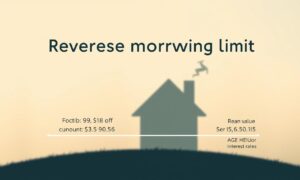As we age, our financial needs often evolve, presenting unique challenges and opportunities. For many older Australians, their home represents their most significant asset. However, accessing this wealth without selling the property can be a conundrum. Enter the reverse mortgage – a financial tool designed to help homeowners aged 60 and above tap into their home equity whilst continuing to live in their cherished abode.
In this comprehensive guide, we’ll explore the ins and outs of reverse mortgages, helping you understand if this option aligns with your retirement goals. Whether you’re considering a reverse mortgage for yourself or assisting a family member in making an informed decision, this article will provide the clarity you need.
Let’s embark on this journey to unravel the complexities of reverse mortgages, shall we?
Understanding Reverse Mortgages: The Basics
Reverse mortgages represent a unique financial product tailored for homeowners in their golden years. Unlike traditional mortgages where you make monthly payments to the lender, a reverse mortgage allows you to borrow against your home’s equity without the burden of regular repayments.
This arrangement can be particularly appealing for retirees who find themselves ‘asset-rich but cash-poor’. It provides a means to access the wealth tied up in your property without the need to downsize or relocate. The loan can be received as a lump sum, regular payments, or a combination of both, offering flexibility to suit various financial needs.
One of the most attractive features of a reverse mortgage is that you retain ownership of your home. You’re not selling your property to the bank; rather, you’re borrowing against its value. This means you can continue to live in your home for as long as you wish, provided you meet certain conditions such as maintaining the property and paying council rates and insurance.
It’s worth noting that the amount you can borrow depends on several factors, including your age, the value of your home, and the specific policies of the lender. Generally, the older you are and the more valuable your property, the more you can borrow.
However, it’s crucial to understand that while you don’t make regular repayments, the interest on the loan compounds over time, increasing the amount you owe. The loan typically becomes due when you sell the home, move into aged care, or pass away.
In the next sections, we’ll delve deeper into how reverse mortgages compare to traditional mortgages, the eligibility criteria, and the potential benefits and risks associated with this financial product.
Reverse Mortgages vs Traditional Mortgages: Key Differences
To truly grasp the concept of reverse mortgages, it’s helpful to compare them with traditional mortgages. While both are secured against your home, they function quite differently. Let’s break down the key distinctions:
Payment Structure
With a traditional mortgage, you borrow a lump sum and make regular repayments to the lender, gradually reducing your debt over time. In contrast, a reverse mortgage doesn’t require monthly repayments. Instead, the loan amount grows as interest accumulates, and the full amount becomes due when you sell the home, move out, or pass away.
Loan Balance
In a traditional mortgage, your loan balance decreases over time as you make payments. With a reverse mortgage, the opposite occurs. Your loan balance increases over time as interest is added to the principal amount borrowed.
Interest Charges
Traditional mortgages typically require you to pay interest monthly. For reverse mortgages, interest is charged but not paid immediately. Instead, it’s added to your loan balance and compounds over time.
Loan Term
Traditional mortgages usually have a fixed term, often 15 to 30 years. Reverse mortgages, however, don’t have a fixed term. The loan continues until a specified event occurs, such as selling the home or the borrower moving into aged care.
Purpose
While traditional mortgages are primarily used for home purchases or refinancing, reverse mortgages are designed to allow homeowners to access their home equity in retirement without selling their property.
Equity
With a traditional mortgage, you build equity in your home over time as you make payments and your property value potentially increases. In a reverse mortgage scenario, your equity may decrease over time as you borrow against it and interest accumulates.
Understanding these differences is crucial when considering whether a reverse mortgage is the right financial tool for your situation. In the next section, we’ll explore who is eligible for a reverse mortgage and what factors lenders consider when approving these loans.
Eligibility Criteria for Reverse Mortgages
Reverse mortgages are not available to everyone. Lenders have specific criteria that borrowers must meet to qualify for this type of loan. Let’s explore the key eligibility requirements:
Age Requirement
The most fundamental criterion for a reverse mortgage is age. In Australia, the minimum age for reverse mortgage borrowers is typically 60 years old. Some lenders may have higher age requirements, and the amount you can borrow often increases with age.
Property Ownership
To be eligible for a reverse mortgage, you must own your home outright or have a substantial amount of equity in it. Most lenders require that you have at least 50% equity in your property.
Property Type and Condition
The property securing the reverse mortgage must be your primary residence. It should be in good condition and adequately maintained. Some lenders may have restrictions on certain types of properties, such as high-rise apartments or rural properties.
Location
While reverse mortgages are available across Australia, some lenders may have restrictions on properties in certain areas, particularly in remote or rural locations.
Financial Assessment
Unlike traditional mortgages, reverse mortgages don’t typically have specific income requirements. However, lenders must satisfy themselves that they are meeting responsible lending criteria and not putting you into financial hardship.
Counselling Requirement
In Australia, it’s mandatory for borrowers to receive independent financial advice before taking out a reverse mortgage. This ensures that you fully understand the implications of the loan.
Existing Mortgages
If you have an existing mortgage on your home, it must be paid off with the proceeds from the reverse mortgage or through other means before or at the time of settlement.
It’s important to note that meeting these eligibility criteria doesn’t guarantee approval for a reverse mortgage. Lenders will also consider factors such as your life expectancy, the projected value of your home, and their own lending policies when making a decision.
In the next section, we’ll delve into how the amount you can borrow through a reverse mortgage is determined.
How Much Can You Borrow with a Reverse Mortgage?
One of the most common questions about reverse mortgages is, “How much can I borrow?” The answer depends on several factors, and it’s important to understand how lenders calculate the maximum loan amount. Let’s break it down:
Age-Based Borrowing Limits
The amount you can borrow is largely determined by your age. Generally, the older you are, the more you can borrow. This is because lenders factor in life expectancy when determining loan amounts. Here’s a general guide for age-based borrowing limits:
- At age 60: You can typically borrow 15-20% of your property value
- At age 65: This increases to about 20-25% of your property value
- For each year over 70: You can usually borrow an additional 1% per year
Property Value
The value of your home plays a crucial role in determining your borrowing capacity. A higher property value generally means you can borrow more. Lenders will typically arrange for a professional valuation of your property as part of the application process.
Interest Rates
The current interest rate environment can affect how much you can borrow. Higher interest rates may reduce the amount you’re eligible to borrow, as the lender needs to account for the faster accumulation of interest over time.
Lender Policies
Different lenders may have varying policies on maximum loan amounts. Some may be more conservative in their lending, while others might offer higher loan-to-value ratios.
Protected Equity
Many lenders implement a ‘protected equity’ feature, which ensures that a portion of your home’s value is preserved. This might limit the amount you can borrow but provides protection against negative equity.
Example Calculation
Let’s consider an example:
Suppose you’re 70 years old and your home is valued at $500,000. Based on the age-based borrowing limits, you might be eligible to borrow around 25-30% of your home’s value. This would equate to approximately $125,000 to $150,000.
However, it’s crucial to remember that this is just an estimate. The actual amount you can borrow will depend on the specific factors mentioned above and the policies of individual lenders.
In the next section, we’ll explore the different ways you can receive funds from a reverse mortgage and how to choose the best option for your needs.
Receiving Funds: Options and Flexibility
One of the appealing aspects of reverse mortgages is the flexibility they offer in terms of how you can receive the funds. Understanding these options can help you tailor the loan to your specific financial needs. Let’s explore the main ways you can access your reverse mortgage funds:
Lump Sum Payment
This option allows you to receive the entire loan amount upfront. It can be useful for major expenses such as home renovations, debt consolidation, or funding a significant purchase. The minimum lump sum typically starts at $10,000, but this can vary between lenders.
Pros:
- Immediate access to a large amount of cash
- Useful for big-ticket expenses or investments
Cons:
- Interest starts accruing on the full amount immediately
- May impact pension eligibility if not spent quickly
Regular Payments
With this option, you receive a fixed amount at regular intervals, creating a steady income stream. This can be particularly helpful for supplementing your retirement income or covering ongoing expenses.
Pros:
- Provides a reliable, consistent income
- Can help with budgeting and long-term financial planning
Cons:
- Less flexibility compared to other options
- May not be suitable for large, one-off expenses
Line of Credit
A reverse mortgage line of credit allows you to draw funds as needed, up to a predetermined limit. Interest is only charged on the amount you’ve actually borrowed.
Pros:
- Flexibility to access funds when needed
- Interest is only charged on the amount used
- Unused credit may increase over time
Cons:
- Requires discipline to manage effectively
- May be tempting to overspend
Combination Approach
Many lenders allow you to combine these options. For example, you might take a portion as a lump sum for immediate needs, set up regular payments for ongoing expenses, and keep a line of credit for emergencies or future use.
Pros:
- Offers maximum flexibility
- Can be tailored to suit various financial needs
Cons:
- More complex to manage
- Requires careful planning to use effectively
When deciding how to receive your funds, consider your immediate financial needs, long-term goals, and how the choice might impact your overall financial situation, including any government benefits you receive.
In the next section, we’ll delve into the costs associated with reverse mortgages, including interest rates and fees.
Understanding the Costs: Interest Rates and Fees
While reverse mortgages can provide valuable financial flexibility, it’s crucial to understand the associated costs. These include interest rates and various fees, which can significantly impact the overall cost of the loan over time. Let’s break down these costs:
Interest Rates
Reverse mortgages typically have higher interest rates compared to standard home loans. You can expect the variable rate to be 1-3 percentage points higher than a standard variable interest rate. This higher rate reflects the increased risk to the lender, as the loan balance grows over time.
Key Points:
- Interest rates are usually variable, meaning they can change over time
- Interest is compounded, which means it’s calculated on the original principal and the accumulated interest from previous periods
- The compounding nature of interest can cause your debt to grow quickly over time
Establishment Fees
These are one-off fees charged at the start of the loan. They may include:
- Application fee
- Valuation fee
- Legal fees
- Settlement fee
These fees can vary significantly between lenders, ranging from a few hundred to several thousand dollars.
Ongoing Fees
Some lenders charge ongoing fees, such as:
- Monthly service fees
- Annual fees
- Discharge fees (when you eventually repay the loan)
Mortgage Insurance
While not always required, some lenders may charge for mortgage insurance to protect against the risk of negative equity.
Example Cost Calculation
Let’s consider an example to illustrate how these costs can add up:
Suppose you borrow $100,000 at age 70 against a property valued at $500,000, with an interest rate of 6.5% p.a. After 10 years, assuming no additional drawdowns and a constant interest rate, your loan balance would grow to approximately $188,000.
If we add establishment fees of $1,500 and annual fees of $100, the total amount owed after 10 years would be around $190,500.
Impact of Fees on Loan Balance
It’s important to note that fees are typically added to your loan balance. This means they also accrue interest over time, further increasing your debt. For this reason, it’s crucial to try to minimise fees wherever possible.
Comparing Costs
When considering a reverse mortgage, it’s essential to compare offers from different lenders. Look not just at the interest rate, but also at the various fees charged. The comparison rate, which includes both the interest rate and fees, can be a useful tool for comparing the true cost of different loans.
In the next section, we’ll explore the potential risks associated with reverse mortgages and how to mitigate them.
Potential Risks and How to Mitigate Them
While reverse mortgages can offer financial benefits, they also come with potential risks that need to be carefully considered. Understanding these risks and how to mitigate them is crucial for making an informed decision. Let’s explore the main risks associated with reverse mortgages:
Equity Erosion
Risk: As interest compounds over time, your home equity can decrease more quickly than you might expect. This could leave you with less to pass on to your heirs or to use for future needs, such as aged care.
Mitigation:
- Only borrow what you need
- Consider a line of credit option to minimise interest
- Regularly review your loan and consider making voluntary repayments if possible
Impact on Government Benefits
Risk: The funds you receive from a reverse mortgage may affect your eligibility for government benefits, such as the Age Pension.
Mitigation:
- Seek financial advice before taking out a reverse mortgage
- Understand how different ways of receiving funds (lump sum vs. regular payments) might impact your benefits
- Consider using the funds for exempt purposes, such as home improvements
Negative Equity
Risk: In the past, there was a risk that you could end up owing more than your home is worth if property values fell or if you lived longer than expected.
Mitigation:
- Reverse mortgages taken out after September 2012 come with a No Negative Equity Guarantee, ensuring you’ll never owe more than your home’s value
- Choose a lender that offers this guarantee
Reduced Inheritance for Heirs
Risk: As your loan balance grows, there may be less equity in your home to leave to your heirs.
Mitigation:
- Discuss your plans with your family
- Consider other estate planning strategies to provide for your heirs
- Only borrow what you need to preserve as much equity as possible
Difficulty Moving or Downsizing
Risk: If you decide to move or downsize in the future, you’ll need to repay the loan, which could limit your options.
Mitigation:
- Consider your long-term housing needs before taking out a reverse mortgage
- Explore other options, such as the government’s Home Equity Access Scheme, which may offer more flexibility
Foreclosure Risk
Risk: While you don’t make regular repayments, you’re still required to maintain the property, pay property taxes, and keep up with insurance. Failure to do so could result in foreclosure.
Mitigation:
- Ensure you have a plan to cover ongoing property expenses
- Set aside funds for maintenance and unexpected repairs
- Stay in regular contact with your lender if you’re experiencing difficulties
Complexity and Misunderstanding
Risk: Reverse mortgages can be complex financial products, and misunderstanding the terms could lead to financial difficulties.
Mitigation:
- Seek independent financial advice before proceeding
- Take advantage of the mandatory financial counselling required for reverse mortgages in Australia
- Ask questions and ensure you fully understand all terms and conditions
By being aware of these risks and taking steps to mitigate them, you can make a more informed decision about whether a reverse mortgage is right for your situation. In the next section, we’ll explore alternatives to reverse mortgages that you might want to consider.
Alternatives to Reverse Mortgages
While reverse mortgages can be a valuable financial tool for some homeowners, they’re not the only option available. It’s important to consider alternatives that might better suit your needs or circumstances. Let’s explore some other options:
Downsizing
Selling your current home and moving to a smaller, less expensive property can free up equity without the need for a loan.
Pros:
- Access to full equity
- Potentially lower maintenance and utility costs
Cons:
- Emotional impact of leaving your home
- Moving costs and potential stamp duty
Home Equity Access Scheme (formerly Pension Loans Scheme)
This government-backed scheme allows eligible pensioners to receive additional income by borrowing against the equity in their home.
Pros:
- Lower interest rates than most reverse mortgages
- More flexible repayment options
Cons:
- Limited to pensioners
- Caps on how much you can borrow
Traditional Home Equity Loan
A standard home equity loan or line of credit allows you to borrow against your home’s equity.
Pros:
- Generally lower interest rates than reverse mortgages
- More familiar product for many people
Cons:
- Requires regular repayments
- May be harder to qualify for on a fixed retirement income
Selling and Renting
Selling your home and becoming a renter can provide access to your home’s full value.
Pros:
- Immediate access to all your home equity
- No maintenance responsibilities
Cons:
- Loss of homeownership
- Ongoing rental costs
Family Agreements
Some families arrange for adult children to provide financial support in exchange for a share of the home’s eventual sale proceeds.
Pros:
- Keeps arrangements within the family
- Potentially more flexible terms
Cons:
- Can strain family relationships if not carefully managed
- Legal complexities
Government Assistance Programs
Various government programs offer financial assistance to seniors, including rent assistance, energy supplements, and health care benefits.
Pros:
- No need to borrow or sell your home
- Preserves your home equity
Cons:
- May not provide as much financial support as other options
- Eligibility criteria can be strict
Refinancing Existing Mortgage
If you still have a mortgage, refinancing to a lower rate or longer term could reduce your monthly payments.
Pros:
- Potentially lower interest rates
- No new loan product to understand
Cons:
- Extends debt into retirement
- May not free up much additional cash
When considering these alternatives, it’s crucial to weigh the pros and cons in the context of your specific financial situation, long-term goals, and personal preferences. Seeking advice from a financial professional can help you navigate these options and choose the best path forward.
In the next section, we’ll discuss the importance of seeking professional advice before making a decision about a reverse mortgage or its alternatives.
The Importance of Professional Advice
When considering a reverse mortgage or any of its alternatives, seeking professional advice is not just recommended—it’s essential. The complexity of these financial products and their potential long-term impact on your financial wellbeing make expert guidance invaluable. Let’s explore why professional advice is crucial and what types of professionals you should consult:
Financial Advisors
A qualified financial advisor can provide comprehensive guidance on how a reverse mortgage fits into your overall financial strategy.
They can help with:
- Assessing your current financial situation
- Projecting future financial needs
- Evaluating the impact on your estate planning
- Comparing reverse mortgages with other financial options
Legal Professionals
A solicitor or conveyancer specialising in property law can provide crucial legal advice.
They can assist with:
- Reviewing and explaining the legal documents
- Ensuring your rights are protected
- Advising on potential legal implications for your estate
Mortgage Brokers
A mortgage broker with experience in reverse mortgages can help you navigate the market.
They can offer:
- Access to a range of lenders and products
- Assistance in comparing different reverse mortgage offers
- Help with the application process
Government Financial Information Service
This free service provided by Services Australia can offer general information about financial products and government benefits.
They provide:
- Information on how financial decisions may affect your pension or benefits
- General guidance on financial products for seniors
Reverse Mortgage Specialists
Some financial advisors specialise in reverse mortgages and can provide in-depth knowledge of these products.
They can offer:
- Detailed explanations of how reverse mortgages work
- Personalised advice based on your specific situation
- Insights into the long-term implications of taking out a reverse mortgage
Benefits of Seeking Professional Advice
- Comprehensive Understanding: Professionals can explain complex terms and conditions in plain language, ensuring you fully understand what you’re considering.
- Personalised Recommendations: They can provide advice tailored to your specific financial situation, goals, and needs.
- Risk Assessment: Experts can help you identify and evaluate potential risks associated with reverse mortgages or alternative options.
- Long-term Planning: They can assist in considering how a reverse mortgage might impact your long-term financial health and estate plans.
- Regulatory Compliance: Professional advisors stay up-to-date with the latest regulations and can ensure any decisions you make comply with current laws.
- Objectivity: Unlike lenders who may have a vested interest in selling a particular product, independent advisors can offer unbiased advice.
- Peace of Mind: Knowing that you’ve received expert advice can provide reassurance in your decision-making process.
Remember, in Australia, it’s mandatory to receive independent financial advice before taking out a reverse mortgage. This requirement is designed to protect consumers and ensure they make informed decisions.
When selecting a professional advisor, look for qualifications, experience specifically related to reverse mortgages or senior financial planning, and check their credentials with relevant professional bodies.
In the final section, we’ll summarise the key points to consider when deciding if a reverse mortgage is right for you.
Conclusion: Is a Reverse Mortgage Right for You?
As we’ve explored throughout this comprehensive guide, reverse mortgages can offer a valuable financial tool for some homeowners aged 60 and above. However, they’re not without their complexities and potential risks. Let’s recap the key points to consider when deciding if a reverse mortgage is the right choice for your situation:
Potential Benefits:
- Access to home equity without selling your property
- No regular repayments required
- Flexibility in how you receive funds (lump sum, regular payments, or line of credit)
- Ability to stay in your home while accessing its value
- Potential to improve your retirement lifestyle or meet unexpected expenses
Key Considerations:
- Long-term Impact: Consider how a reverse mortgage might affect your future financial options and the inheritance you leave behind.
- Costs: Be aware of the higher interest rates and fees associated with reverse mortgages compared to traditional loans.
- Compound Interest: Understand how your debt can grow over time due to compound interest.
- Eligibility: Ensure you meet the age and property requirements for a reverse mortgage.
- Alternatives: Explore other options like downsizing, government schemes, or traditional loans before deciding.
- Professional Advice: Seek guidance from financial advisors, legal professionals, and reverse mortgage specialists.
- Family Discussion: Consider discussing your plans with family members who might be affected by your decision.
- Future Plans: Think about how a reverse mortgage aligns with your long-term housing and care needs.
- Government Benefits: Understand how taking out a reverse mortgage might impact your pension or other benefits.
- Protections: Ensure any reverse mortgage you consider includes the No Negative Equity Guarantee.
Final Thoughts:
A reverse mortgage can be an excellent solution for many homeowners, offering financial flexibility and the ability to age comfortably in your own home. However, it’s crucial to recognise that this financial tool isn’t a one-size-fits-all product. Your unique circumstances, financial goals, and comfort with the loan terms should all play a vital role in your decision-making process.
This is where the expertise of Synergy Mortgage Brokers Sunshine Coast becomes invaluable. With their personalised service and extensive experience, Synergy stands out in guiding you through the complexities of reverse mortgages. Their transparent process ensures you fully understand every aspect of your potential loan, while their post-loan support provides ongoing peace of mind.
Remember, there’s no rush to make this significant financial decision. Take the time to thoroughly research, seek professional advice, and discuss with your family. Consider not just your immediate financial needs, but also your long-term plans and how a reverse mortgage might impact them.
By leveraging Synergy Mortgage Brokers’ expertise, understanding how reverse mortgages work, and considering all your options, you’re well-equipped to make an informed decision about whether this financial tool is the right fit for your retirement planning. Trust in Synergy to illuminate your path to a secure and comfortable retirement.



































